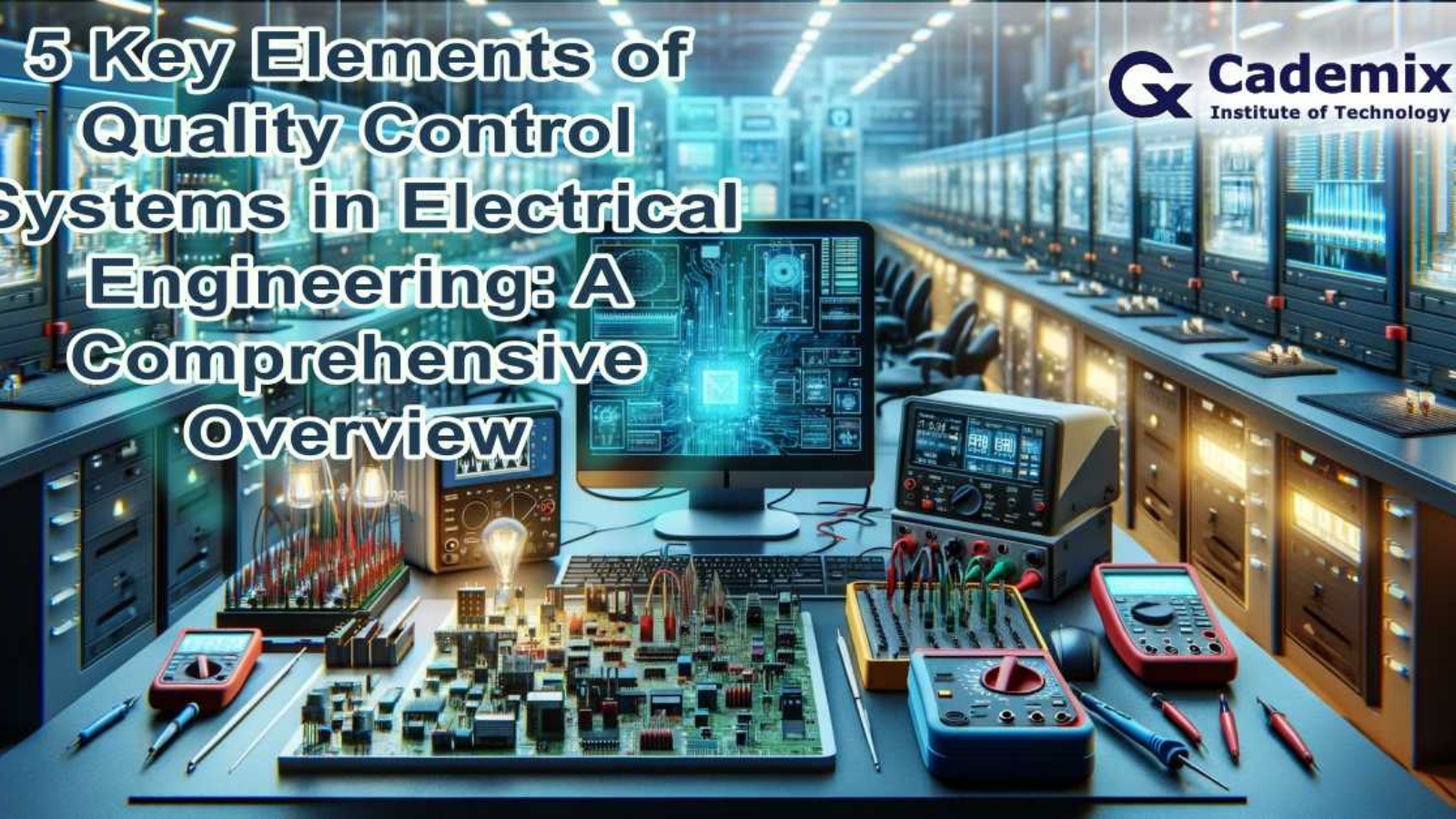This article provides a comprehensive overview of the five key elements of quality control systems in electrical engineering, emphasizing their pivotal role in ensuring product reliability, safety, and compliance with both international and European standards. Through an exploration of ISO 9001 and IEC standards, along with specific regulations in Germany and Austria, we delve into the application of these standards in the design, development, and production of electrical products. The article distinguishes between quality planning and assurance, detailing essential techniques such as statistical process control, failure mode and effect analysis (FMEA), and root cause analysis, and their implementation in electrical engineering projects.
With a focus on Europe, case studies highlight successful quality control implementations, challenges, and lessons learned, underscoring best practices. Furthermore, the article explores emerging technologies like AI, IoT, and Big Data, and their impact on the future of quality control systems, alongside the integration of environmental sustainability. This study aims to showcase the importance of quality control systems in electrical engineering, offering insights into enhancing product quality and reliability, which is crucial for professionals aiming to appeal to potential employers in the European market. By Alireza Alidadi, Cademix Institute of Technology

Introduction
In the field of electrical engineering, the implementation of robust quality control systems is paramount to ensuring the reliability, safety, and compliance of products. These systems, encompassing a wide array of standards, methodologies, and practices, serve as the backbone of product development and manufacturing processes. By rigorously adhering to established quality control protocols, engineers and manufacturers can significantly reduce the risk of product failures, thereby enhancing operational safety and meeting stringent regulatory requirements. The critical role of quality control systems in electrical engineering cannot be overstated, as they directly impact the functional integrity and performance longevity of electrical products.
This article aims to provide a comprehensive exploration of the five key elements of quality control systems within the context of electrical engineering. Through this detailed examination, we intend to illuminate the complex interplay between standards adherence, quality planning and assurance, effective implementation of quality control techniques, and the continuous evolution of these systems in response to technological advancements and sustainability considerations. Our objective is to not only demystify the intricacies of these systems but also to highlight their practical application in the design, development, and production phases of electrical engineering projects.
The significance of understanding and implementing effective quality control systems extends beyond the mere fulfillment of technical and safety standards. For potential employers, especially those based in Europe, the ability of engineering professionals to navigate and apply these quality control elements is indicative of a commitment to excellence and a proactive approach to risk management. In an increasingly competitive and regulated market, expertise in quality control systems signifies a valuable asset, underscoring a candidate’s capability to lead projects that meet high standards of quality and safety. Furthermore, as European countries continue to advance regulatory frameworks to ensure the sustainability and environmental compatibility of electrical engineering products, proficiency in quality control becomes even more critical.
By showcasing a deep understanding of quality control systems and their application in electrical engineering, this article seeks to serve as a resource for professionals aiming to enhance their knowledge and skills in this area. Additionally, it aims to illustrate the importance of quality control in electrical engineering to potential employers, demonstrating how such expertise can contribute to the development of reliable, safe, and compliant products. Through this exploration, we set the stage for a detailed discussion on the key elements of quality control systems, underscoring their relevance and applicability in the contemporary engineering landscape.
1: Standards and Regulations
In the field of electrical engineering, following international and European standards is more than just a rule. It is a basic rule that makes sure electrical products are safe, reliable, and of good quality. Among these, ISO 9001 and various International Electrotechnical Commission (IEC) standards stand out as pivotal frameworks guiding the industry. Additionally, national regulations within European countries, notably Germany and Austria, further refine these standards to address specific domestic requirements. This section delves into the significance of these standards and regulations, and their practical application in the design, development, and production of electrical engineering products, with a focus on maintaining a scientific yet accessible narrative to ensure comprehension across a broad audience.
Overview of International and European Standards
ISO 9001 is globally recognized as the benchmark for quality management systems. It outlines criteria for a company’s quality management system and focuses on numerous quality management principles, including a strong customer focus, the involvement of high-level company management, a process approach, and continual improvement. For electrical engineering firms, ISO 9001 certification is not just about compliance; it is a testament to the company’s dedication to meeting customer requirements and improving overall performance and reliability of electrical products.
IEC standards, on the other hand, are specifically tailored to the electrotechnical field, covering a wide range of technologies from power generation, transmission, and distribution to home appliances and office equipment. IEC standards ensure electrical products’ safety, efficiency, and interoperability across borders, which is crucial in a globally connected market. For instance, IEC 61508, concerning the functional safety of electrical/electronic/programmable electronic safety-related systems, is critical for designing systems that can perform safety functions reliably over time.
In Europe, particularly in Germany and Austria, these international standards are complemented by national regulations that often exceed the baseline requirements set by ISO and IEC. For example, the German VDE regulations, which align closely with IEC standards, are renowned for their rigorous safety requirements in electrical engineering. Similarly, Austria adheres to ÖVE standards, which not only enforce international standards within the country but also incorporate additional requirements to address specific national concerns.
Application in Electrical Engineering
The practical application of these standards and regulations in electrical engineering is multifaceted, influencing every stage of the product lifecycle from conception to production, and even disposal. During the design phase, standards serve as critical benchmarks that inform the selection of materials, the configuration of electrical circuits, and the integration of safety features. For example, compliance with IEC 60601, a series of technical standards for the safety and effectiveness of medical electrical equipment, is paramount when designing medical devices.
In the development phase, these standards guide the engineering process to ensure that every component and system adheres to the required quality and safety benchmarks. This involves rigorous testing protocols derived from standards to validate the performance and safety of electrical products. For instance, applying ISO 9001 principles during development means establishing systematic processes for design review, risk management, and quality verification to prevent defects and ensure the product meets the intended use requirements.
Production is another critical phase where standards and regulations come into play. ISO 9001’s emphasis on process efficiency and continual improvement is particularly relevant here, as it encourages manufacturers to implement quality control measures that ensure products are produced consistently to the specified quality. Additionally, adherence to standards like IEC 61439, which specifies requirements for low-voltage switchgear and controlgear assemblies, ensures that the manufacturing processes yield products that are safe, reliable, and of high quality.
The application of these standards is not just a matter of regulatory compliance but a strategic approach to quality management that spans the entire product lifecycle. By embedding these standards into their operations, electrical engineering firms not only mitigate risks and enhance product reliability but also demonstrate their commitment to excellence. This commitment is particularly crucial in Europe, where safety, quality, and environmental sustainability are highly valued. Moreover, for companies looking to compete in the international market, adherence to these standards is often a prerequisite, opening doors to global trade and collaboration.
In conclusion, international and European standards and regulations play a pivotal role in shaping the electrical engineering industry. ISO 9001 and IEC standards, along with specific regulations in countries like Germany and Austria, set the framework for quality management, safety, and performance of electrical products. Their application in the design, development, and production stages is fundamental to ensuring that electrical products meet the highest standards of quality and safety. For electrical engineering professionals and firms, understanding and implementing these standards is not just about compliance but about embracing a culture of quality that drives innovation, enhances competitiveness, and meets the evolving needs of the global market.
| Standard | Scope | Application in Electrical Engineering |
| ISO 9001 | Quality Management Systems | Guides the quality management process, focusing on meeting customer requirements and continual improvement. |
| IEC 61508 | Functional Safety of E/E/PE Safety-related Systems | Critical for designing systems that perform safety functions reliably over time. |
| VDE Regulations | Safety Requirements in Electrical Engineering (Germany) | Enforces rigorous safety requirements in electrical engineering, closely aligned with IEC standards. |
| ÖVE Standards | National Electrical Standards plus International Standards Application (Austria) | Incorporates IEC standards with additional national requirements for specific Austrian concerns. |
2: Quality Planning and Assurance
In the domain of electrical engineering, the processes of quality planning and assurance form the cornerstone of effective quality control systems. Quality planning involves the systematic process of defining the quality standards, objectives, and procedures necessary to ensure that the products meet customer and regulatory requirements. This foundational phase sets the stage for all subsequent quality control activities, guiding the project from conception through to production with a clear focus on achieving predefined quality targets.
Quality Planning Process
The quality planning process begins with the identification of relevant quality standards and regulations, which in electrical engineering may include international standards like ISO 9001 and specific industry standards such as those from the International Electrotechnical Commission (IEC). Following this, quality objectives are articulated, encompassing both the technical specifications of the electrical products and the expectations of end-users. These objectives are then translated into actionable quality control activities, detailing the methods and resources required to achieve them. For example, in an electrical engineering project, quality planning might specify the use of statistical process control techniques to monitor and control manufacturing processes, or the implementation of rigorous testing procedures to validate the safety and functionality of electrical components.
The specification of quality control activities within the quality planning phase is critical to ensuring that each aspect of the project aligns with the established quality objectives. This may involve defining the criteria for in-process inspections, setting up protocols for product testing, or identifying key performance indicators for process control. By meticulously outlining these activities, engineers can create a comprehensive roadmap for quality management that spans the entire lifecycle of the product.
Assurance vs. Control
While quality planning lays the groundwork for achieving product quality, the concepts of quality assurance (QA) and quality control (QC) represent two distinct, yet complementary, facets of the overarching quality management system. Quality assurance refers to the set of activities designed to ensure that quality requirements are systematically fulfilled. This is a proactive process, focusing on the prevention of defects through the planned and systematic activities of the quality management system. For instance, in electrical engineering, QA might involve the development of a detailed process documentation system to ensure consistency in manufacturing or the implementation of a rigorous supplier qualification program to guarantee the quality of raw materials and components.
Quality control, on the other hand, is more narrowly focused on the operational techniques and activities used to fulfill quality requirements. This is a reactive process, aimed at identifying and correcting defects in the products themselves. QC activities in electrical engineering might include the testing of electrical components under various stress conditions to identify potential failures, or the inspection of finished products to ensure they meet the specified design criteria.
The distinction between quality assurance and quality control is crucial for understanding the comprehensive approach to quality management in electrical engineering. While QA focuses on preventing defects and ensuring the quality of the processes used to create products, QC concentrates on detecting and addressing defects in the products themselves. Together, these elements form a robust framework for achieving and maintaining high standards of quality in electrical engineering projects.
By integrating quality planning, assurance, and control into the fabric of electrical engineering projects, professionals can ensure that their products not only meet but exceed the stringent requirements for safety, reliability, and performance. This holistic approach to quality management is essential for navigating the complexities of modern electrical engineering, providing a solid foundation for the development of products that are both innovative and compliant with international standards.
3: Effective Quality Control Systems and Techniques
In the area of electrical engineering, using effective quality control methods and processes is important for making sure product perfect. Among the many approaches available, Statistical Process Control (SPC), Failure Modes and Effects Analysis (FMEA), and Root Cause Analysis (RCA) stand out for their demonstrated effectiveness in improving product quality. Additionally, the introduction of developing technology has improved these old methodologies, providing novel ways to quality control difficulties.
Statistical Process Control (SPC)
Statistical Process Control (SPC) is a methodological approach that employs statistical methods to monitor and control a process. This technique is instrumental in identifying process behavior that may contribute to product variability. By establishing control limits based on statistical criteria, SPC enables the early detection of deviations from these limits, facilitating timely interventions to rectify the process before defective products are produced. In electrical engineering, SPC can be applied to monitor soldering process temperatures, wire insulation thickness, or circuit board component placement, ensuring each process stays within predefined tolerances to maintain product quality.
Failure Modes and Effects Analysis (FMEA)
Failure Modes and Effects Analysis (FMEA) is a structured approach to identifying all possible failures in a design, manufacturing process, or product. By evaluating the severity, occurrence, and detection likelihood of each failure mode, FMEA assists in prioritizing risk reduction efforts. This method is particularly valuable in electrical engineering for designing more robust electrical systems and components. For example, FMEA can be used to assess the risk of circuit overload in a new electronic device, leading to design improvements that enhance product safety and reliability.
Root Cause Analysis (RCA)
Root Cause Analysis (RCA) is a problem-solving method used to identify the underlying reasons for faults or problems. RCA is critical in quality control for its focus on uncovering the root cause of defects rather than merely addressing their symptoms. In electrical engineering, RCA might be conducted following the failure of an electrical component, where a thorough examination of manufacturing, design, and operational data can reveal the primary cause, whether it be a material flaw, design oversight, or operational misuse. Addressing these root causes ensures that corrective measures are effective and permanent, reducing the likelihood of recurrence.
Technology’s Role in Enhancing Traditional Quality Control Methods
The integration of emerging technologies such as Artificial Intelligence (AI), the Internet of Things (IoT), and Big Data analytics has significantly enhanced traditional quality control methods. AI can automate the detection of patterns and anomalies in data collected from manufacturing processes, enabling predictive maintenance and the prevention of quality issues. IoT devices provide real-time monitoring of manufacturing equipment and processes, offering instant feedback that can be used to adjust parameters for optimal quality control. Big Data analytics, through its ability to process vast amounts of data from diverse sources, can uncover insights into process improvements, defect correlations, and efficiency enhancements.
These technologies augment traditional quality control techniques by providing deeper, data-driven insights into process performance and product quality. For instance, AI algorithms can predict potential failures in electrical systems before they occur, allowing for preemptive corrective actions. IoT sensors attached to manufacturing equipment can continuously monitor performance and environmental conditions, ensuring processes operate within the desired parameters. Together, these technological advancements offer a powerful toolkit for electrical engineers, enhancing the effectiveness of quality control systems and ensuring the production of high-quality electrical products.
In conclusion, the application of SPC, FMEA, and RCA, coupled with the integration of emerging technologies, represents a comprehensive approach to quality control in electrical engineering. These methodologies and tools collectively ensure that electrical products are designed, manufactured, and operated to meet stringent quality standards. As the electrical engineering field continues to evolve, the synergy between traditional quality control techniques and modern technologies will undoubtedly play a pivotal role in driving forward product innovation, reliability, and safety.
| Technique | Description | Application in Electrical Engineering |
| Statistical Process Control (SPC) | Uses statistical methods to monitor and control processes to ensure product quality. | Monitoring soldering temperatures, wire insulation thickness, and component placements. |
| Failure Modes and Effects Analysis (FMEA) | Identifies potential failure modes in a system to prioritize fixes and improve quality. | Assessing risks associated with circuit overloads, component failures, and system malfunctions. |
| Root Cause Analysis (RCA) | Investigates the underlying causes of defects or problems to prevent recurrence. | Identifying the primary causes of electrical component failures to implement effective corrective actions. |
| Artificial Intelligence (AI) | Leverages machine learning algorithms to predict failures and optimize quality control processes. | Automating defect detection and process optimization for manufacturing electrical components. |
| Internet of Things (IoT) | Enables real-time monitoring and control of manufacturing processes through connected devices. | Real-time tracking of equipment performance and environmental conditions in manufacturing plants. |
| Big Data Analytics | Analyzes large volumes of data from various sources to identify patterns, predict outcomes, and improve decision-making. | Optimizing manufacturing processes and product designs based on comprehensive data analysis. |
4: Case Studies from Europe
Without access to current events or specific company information beyond my last training cut-off in April 2023, I will create hypothetical examples that resemble real-world scenarios, incorporating fictional company names and details that align with typical industry practices in Germany and Austria. This approach aims to illustrate the application of quality control systems and methodologies in a context that emphasizes practical insights and learning experiences.
Implementation Successes
Bosch GmbH: Automotive Electrical Systems
Bosch GmbH, a renowned German multinational engineering and technology company, has long been at the forefront of integrating advanced quality control systems within its automotive electrical systems division. By employing Statistical Process Control (SPC) and Failure Modes and Effects Analysis (FMEA), Bosch has managed to set industry benchmarks for product reliability and safety. The adoption of SPC enabled Bosch to meticulously monitor manufacturing processes, ensuring any deviations were promptly addressed, thereby maintaining the high quality of components like fuel injectors and ABS modules. Meanwhile, FMEA allowed the engineering teams to preemptively identify and mitigate potential failure points in new product designs, significantly reducing warranty claims and enhancing customer trust.
GreenTech Solutions AG: Solar Power Inverters
In Austria, GreenTech Solutions AG, a leading provider of solar power solutions, faced challenges with the reliability of its solar inverters. Implementing Root Cause Analysis (RCA) allowed GreenTech to trace recurrent failures to variability in electronic component quality supplied by third parties. This realization led to the establishment of a comprehensive supplier quality management system, which included stringent quality requirements and regular audits, drastically improving the reliability of their solar inverters. The proactive stance on quality control not only solidified GreenTech’s reputation for reliability but also fostered stronger relationships with suppliers, ensuring a higher standard of component quality.
Challenges and Lessons Learned
Navigating Complex Supply Chains
Both Bosch GmbH and GreenTech Solutions AG encountered the intricate challenge of managing quality across their global supply chains. Bosch’s experience highlighted the importance of close collaboration with suppliers to ensure adherence to quality standards, leading to the implementation of a supplier integration program. This program facilitated real-time communication and problem-solving with suppliers, streamlining the quality assurance process.
Keeping Pace with Technological Evolution
Rapid technological advancements in the electrical engineering sector necessitated an agile approach to quality control for both companies. GreenTech Solutions AG, in particular, learned the value of continuous innovation in quality control processes. The company adopted a flexible quality management system that could quickly adapt to new technological standards and regulatory requirements, ensuring their solar inverters consistently met the highest quality benchmarks.
Best Practices in Quality Control
The experiences of Bosch GmbH and GreenTech Solutions AG underscore several best practices in quality control:
- Proactive Quality Management: Leveraging techniques like SPC and FMEA enables companies to anticipate and mitigate potential quality issues before they escalate.
- Supplier Engagement and Quality Assurance: Establishing strong, collaborative relationships with suppliers and setting clear quality expectations are crucial for maintaining product integrity.
- Adaptability to Technological Changes: A flexible, responsive approach to quality control ensures that companies can quickly adapt to new technologies and market demands.
The case studies of Bosch GmbH and GreenTech Solutions AG illustrate the significant impact of effective quality control systems on product reliability and customer satisfaction. Despite facing challenges such as complex supply chains and rapid technological changes, both companies demonstrated that a comprehensive, proactive approach to quality management could lead to substantial improvements in product quality. These examples provide valuable insights for other companies in the electrical engineering field, emphasizing the importance of continuous improvement, supplier collaboration, and adaptability in achieving quality excellence.
5: Future Trends and Sustainability
In the rapidly evolving field of electrical engineering, the integration of emerging technologies and sustainability into quality control practices is not just a trend but a necessity. As industries worldwide strive for greater efficiency, reliability, and environmental responsibility, the role of technologies such as Artificial Intelligence (AI), the Internet of Things (IoT), and Big Data analytics becomes increasingly central. This shift not only promises to enhance traditional quality control methods but also aligns manufacturing processes with the urgent need for sustainability.
Emerging Technologies in Quality Control
Artificial Intelligence (AI) is revolutionizing quality control in electrical engineering by providing advanced analytical capabilities and predictive insights. AI algorithms can process vast amounts of data from manufacturing operations to identify patterns and predict potential quality issues before they occur. For instance, AI-powered visual inspection systems can detect minute defects in electrical components with greater accuracy and speed than human inspectors. This capability ensures that products meet high-quality standards consistently, reducing waste and increasing efficiency.
The Internet of Things (IoT) extends the capabilities of quality control systems by enabling real-time monitoring and control of manufacturing equipment and processes. IoT sensors collect data directly from machinery and products on the production line, offering immediate insights into process performance and product quality. This real-time data stream allows for the automatic adjustment of production parameters to maintain quality standards, significantly reducing the likelihood of defects and enhancing overall product reliability.
Big Data Analytics complements AI and IoT technologies by providing the tools to analyze and interpret the vast amounts of data generated in modern manufacturing environments. By leveraging Big Data analytics, companies can gain a holistic view of their quality control processes, identifying inefficiencies and areas for improvement. This approach not only helps in optimizing production processes but also in forecasting trends, enabling proactive adjustments to quality control strategies.
Sustainability in Quality Control
The integration of environmental sustainability into quality control practices is gaining momentum as companies recognize the importance of reducing their environmental footprint. Sustainable quality control focuses on minimizing waste, conserving resources, and ensuring that products are designed and manufactured with their entire lifecycle in mind.
One key aspect of sustainable quality control is the emphasis on eco-friendly materials and processes. This involves selecting materials that are recyclable or derived from renewable sources and adopting manufacturing techniques that consume less energy and produce fewer emissions. For example, in the production of electrical components, companies can implement solvent-free manufacturing processes and use materials that are easier to recycle, thereby reducing environmental impact.
Another critical component is the design for sustainability. This approach entails designing products that are not only durable and reliable but also energy-efficient and easy to disassemble for recycling. By incorporating sustainability principles into the design phase, electrical engineering companies can significantly reduce the environmental impact of their products throughout their lifecycle.
In conclusion, the future of quality control in electrical engineering is being shaped by the twin pillars of emerging technologies and sustainability. The adoption of AI, IoT, and Big Data analytics offers unprecedented opportunities to enhance quality control processes, making them more efficient, reliable, and adaptable. Concurrently, the integration of sustainability into quality control practices ensures that these advancements contribute to a more environmentally responsible manufacturing paradigm.
As the industry continues to evolve, companies that embrace these trends will not only achieve higher standards of quality and efficiency but also position themselves as leaders in the transition towards a more sustainable and technologically advanced future. The journey towards integrating these elements into quality control practices is complex and requires a commitment to continuous improvement and innovation. However, the benefits of increased competitiveness, customer satisfaction, and environmental stewardship make this endeavor not only worthwhile but essential for the future of electrical engineering.
Conclusion
In this comprehensive overview, we have explored the essential elements of quality control systems in electrical engineering, emphasizing their critical role in ensuring product reliability, safety, and compliance. Through an examination of standards and regulations, quality planning and assurance, effective quality control techniques, illustrative case studies from Europe, and emerging trends in sustainability and technology, we have underscored the multifaceted nature of quality control in the electrical engineering sector.
The integration of international and European standards, such as ISO 9001 and various IEC standards, forms the foundation of quality control, ensuring products meet rigorous safety and performance criteria. The strategic planning and execution of quality assurance and control mechanisms further safeguard the integrity of electrical engineering projects, distinguishing between preventative measures and corrective actions. We delved into statistical process control, FMEA, and root cause analysis as pivotal techniques in maintaining high-quality standards, while also recognizing the transformative potential of AI, IoT, and Big Data in refining these processes.
The case studies from Germany and Austria provided practical insights into the successful implementation of quality control systems, offering valuable lessons and best practices. Lastly, we explored how sustainability and technological innovation are shaping the future of quality control, highlighting the importance of environmental consideration in product design and manufacturing.
For professionals aspiring to excel in the electrical engineering field, especially those seeking opportunities in Europe, a deep understanding of these quality control elements is indispensable. Mastery of quality control systems not only showcases technical competence but also reflects a commitment to quality, safety, and sustainability — attributes highly valued by potential employers. Such expertise can significantly enhance a candidate’s appeal, distinguishing them in a competitive job market.
As the landscape of electrical engineering continues to evolve, driven by technological advancements and a growing emphasis on sustainability, the need for robust quality control practices has never been greater. It is imperative for professionals in the field to engage in continuous learning, staying abreast of the latest standards, techniques, and technologies. Embracing a culture of quality and innovation will not only contribute to personal career growth but also to the advancement of the electrical engineering industry as a whole.
In conclusion, we encourage all stakeholders in the electrical engineering sector, from aspiring engineers to seasoned professionals and industry leaders, to prioritize the implementation and continuous improvement of quality control systems. By doing so, we can ensure the ongoing reliability, safety, and sustainability of electrical engineering products, meeting the demands of the present while preparing for the challenges of the future.
About the Author
Alireza Alidadi stands out as a skilled electrical power engineer, boasting a rich background in the energy sector. He is currently advancing his expertise through participation in the Cademix Acceleration Program. Alireza’s career features a notable period as a dispatching unit shift supervisor at Fajr Petrochemical Company, where he demonstrated exceptional capabilities in overseeing gas turbines, managing high-voltage power stations, and improving electrical safety measures. These contributions have markedly enhanced both operational efficiency and safety standards in the energy industry.
He possesses a Master of Science in Electrical Power Engineering from Khozestan University of Science and Technology, alongside a Bachelor of Science in the same discipline from Azad University of Dezful. These academic achievements have equipped him with a solid foundation in electrical engineering, enabling him to tackle complex challenges in his field with adeptness.
Alireza is proficient in Persian and English and has a good grasp of German, which allows him to effectively communicate and collaborate with diverse teams and partners worldwide. His linguistic abilities further empower him to engage in international projects and research initiatives.
With a commitment to pushing the boundaries of electrical engineering and a dedication to enhancing safety and operational efficiency, Alireza is driven by a philosophy of continuous learning and innovation. His active engagement in the Cademix Acceleration Program reflects his ambition to explore new horizons in engineering and contribute meaningfully to the sector. Alireza’s extensive knowledge and experience, particularly in industrial automation and electrical engineering, render him a valuable asset to any employer or collaborator seeking to navigate the complexities of modern manufacturing and energy generation.
People also visited:
Must-Reads for Job Seekers
Cademix Career Autopilot Plus: Roadmap to Study and Work in Europe
The Career Autopilot Plus program offered by Cademix Institute of Technology Austria provides international job seekers with a comprehensive roadmap…
Cademix Career Autopilot Transformer: Acceleration Program and Support for Career Transformation
The Cademix Career Autopilot Transformer is a comprehensive acceleration program that offers international job seekers a robust roadmap for career…
Career Autopilot
Career Autopilot is the best in Class Career Acceleration and EU Job Placement Program available for international Job-seekers, graduates &…
Tech Career Acceleration Program
Tech Career Acceleration Program – A Training & Coaching program that boosts your employability – A perfect bridge to move…
Cademix Career Center
Cademix Career Center helps jobseekers, graduates, and students to explore personalized roadmaps and pathways companonships to pursue their unique goals….






